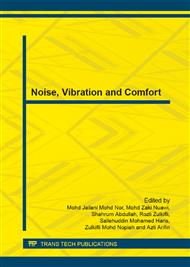[1]
Ministry of Health, Labour and welfare, Estimation number of physically handicapped person in japan.
Google Scholar
[2]
Http: /www. mhlw. go. jp/houdou/2002/08/h0808-2. html.
Google Scholar
[3]
S. Garg, S. Chadha, S. Malhotra and A.K. Agarwal, Deafness: Burden, prevention and control in India, in The National Medical Journal of India, Vol. 22, No. 2, pp.79-81, (2009).
Google Scholar
[4]
Frank A. Saunders, An Electrotactile sound detector for the deaf, IEEE Transactions on Audio and Electroacoustics, Vol, AU-21, No 3, June, (1973).
DOI: 10.1109/tau.1973.1162451
Google Scholar
[5]
Frank A. Saunders et. al., A Wearable Tactile Sensory Aid for Profoundly Deaf Children, Journal of Medical Systems, Vol 5., No 4., (1981).
Google Scholar
[6]
Arthur Boothroyd, Wearable Tactile Sensory Aid Providing Information on voice Pitch and Intonation Patterns, Research Corporation, New York. (1986).
DOI: 10.1121/1.394415
Google Scholar
[7]
Hanguang Xiao, Congzhong Cai, Qianfei Yuan, Xinghua Liu, Yufeng Wen, A Comparative Study of feature Extraction and Classification Methods for Military Vehicle Type Recognition Using Acoustic and Seismic Signals, Department of Applies Physics, Chongqing University and Chongqing Institute of Technology, Chongqing, China.
DOI: 10.1007/978-3-540-74171-8_81
Google Scholar
[8]
R. B. Randall, Frequency Analysis, Brüel & Kjær, (1987).
Google Scholar
[9]
Amir Y.N., Mark D., Denis McKeown and Howard R. K, A field trial of Acoustic Signature Analysis for Vehicle Classification, Vol 5, No 3/4, pp.165-177, Elsevier Science Ltd. (1997).
Google Scholar
[10]
W. Huadong, M. Siegel, and P. Khosla, Vehicle sound signature recognition by frequency vector principal component analysis, in Instrumentation and Measurement Technology Conference, 1998. IMTC/98. Conference Proceedings. IEEE, 1998, pp.429-434.
DOI: 10.1109/imtc.1998.679823
Google Scholar
[11]
Kazuhide Okada, Gwan Kim and Pyong Sik Pak, Sound Information Notification System by Two-Channel Electrotactile Stimulation for Hearing Impaired Persons, Proceedings of the 29th Annual International, Conference of the IEEE EMBS, Cite Internationale Lyon, France.
DOI: 10.1109/iembs.2007.4353166
Google Scholar
[12]
Joes E. Lopez, Hung Han Chen and Jennifer Saulnier, Target Identitfication Using Wavelet-based Feature Extraction and Neural Network Classifiers, Cytel Systems, inc. Hudson.
Google Scholar
[13]
Averbuch, E. Hulata, V. Zheludev and I. Kozlov, A Wavelet Packet Algorithm for Classification and Detection of Moving Vehicles, Multidimensional Systems and Signal Processing, vol. 12, pp.9-31, (2001).
DOI: 10.1023/a:1008455010040
Google Scholar
[14]
Averbuch, V. A. Zheludev, N. Rabin, and A. Schclar, Wavelet-based acoustic detection of moving vehicles, Multidimensional Systems and Signal Processing, vol. 20, pp.55-80, (2009).
DOI: 10.1007/s11045-008-0058-z
Google Scholar
[15]
H. Maciejewski, J. Mazurkiewicz, K. Skowron, and T. Walkowiak, Neural Networks for Vehicle Recognition, in Proceeding of the 6th International Conference on Microelectronics for Neural Networks, Evolutionary and Fuzzy Systems, 1997, p.5.
Google Scholar
[16]
Bhanu Prasad, S.R.M. Prasanna, Speech, Audio, Image and Biomedical Signal Processing using Neural Networks, Studies in Computational Intelligence, vol. 83, pp.169-188, ISBN 978-3-540-75397-1, Springer (2008).
DOI: 10.1007/978-3-540-75398-8
Google Scholar
[17]
S. N Sivanandam and Paulraj M, An Introduction to Artificial Neural Networks, Vikhas Publication, India, (2003).
Google Scholar
[18]
T. Masters, Practical Neural Network Recipes in C++, Academic Press, New York (1993).
Google Scholar


